|
BATTLE OF MAL TIEMPO (BATALLA DE MAL TIEMPO)
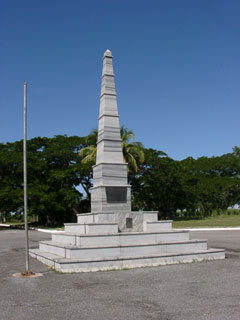 This historical site, located in the municipality of Cruces, is within a park surrounded by a paved area that acts as an access to the obelisk. It has a stepped structure in a pyramidal form, and is located at the centre of the park surrounded by colonial ruins.
On December 15th of 1895, the invading column of Maceo and Gómez started moving in order to penetrate the territory of Cienfuegos; and made camp in Cruces, an important sugar region of the country’s central area.
In the settlement next to Mal Tiempo, the Spanish columns that were trying to cut off the advance of the Mambi troops, were attacked by the Cuban forces, producing a great battle in the middle of the Cienfuegos lands. This military and political feat covered the Invading Army (Ejército Invasor) with glory and dealt a hard blow to Spain’s aspirations of quenching the insurrectional struggle along the length of the island.
It was declared a National Monument on December 15th of 1981.
This historical site, located in the municipality of Cruces, is within a park surrounded by a paved area that acts as an access to the obelisk. It has a stepped structure in a pyramidal form, and is located at the centre of the park surrounded by colonial ruins.
On December 15th of 1895, the invading column of Maceo and Gómez started moving in order to penetrate the territory of Cienfuegos; and made camp in Cruces, an important sugar region of the country’s central area.
In the settlement next to Mal Tiempo, the Spanish columns that were trying to cut off the advance of the Mambi troops, were attacked by the Cuban forces, producing a great battle in the middle of the Cienfuegos lands. This military and political feat covered the Invading Army (Ejército Invasor) with glory and dealt a hard blow to Spain’s aspirations of quenching the insurrectional struggle along the length of the island.
It was declared a National Monument on December 15th of 1981.
For more information:
www.cuba-geography.com
,
www.cuba-heroes.com
,
www.cuba-history.com
,
www.cuba-cienfuegos.com
|
|
|
Botanical Garden, Cienfuegos
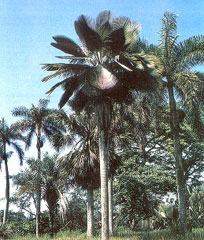 This hundred-year-old institution is the oldest of its kind in the country and offers the national as well as the foreign visitor the possibility of admiring well cared for plants originating from all parts of the planet. The incomparable greenery envelops the whole garden of the Pearl of the South and its palm collection is so complete that experts have stated that it can be considered one of the most complete worldwide.
Over a thousand species, from the exuberant Ceiba tree to a herbarium containing great varieties of the beautiful Caribbean flora, can be seen. This majestic park in Cienfuegos treasures many arboreal species as well as fruit trees, and includes an area for the conservation of exotic plants. Due to its attributes this botanical garden has been declared a National Monument.
This hundred-year-old institution is the oldest of its kind in the country and offers the national as well as the foreign visitor the possibility of admiring well cared for plants originating from all parts of the planet. The incomparable greenery envelops the whole garden of the Pearl of the South and its palm collection is so complete that experts have stated that it can be considered one of the most complete worldwide.
Over a thousand species, from the exuberant Ceiba tree to a herbarium containing great varieties of the beautiful Caribbean flora, can be seen. This majestic park in Cienfuegos treasures many arboreal species as well as fruit trees, and includes an area for the conservation of exotic plants. Due to its attributes this botanical garden has been declared a National Monument.
For more information:
www.cuba-botanicalgardens.com
,
www.cuba-flora.com
,
www.cuba-cienfuegos.com
|
|
|
CIENFUEGOS
 Located some 244 kilometres from the capital, in the south central region of the country, this city features the beautiful Bay of Jagua (Bahía de Jagua), in whose deep waters abound shads, a species coveted by fishermen.
Traditionally, there are rowing competitions held here and the beaches such as Rancho Luna and El Inglés are wonderful scenarios for scuba diving and contemplating the beautiful marine corals, among them Notre Dame with its impressive six feet of height.
The well named Pearl of the South (Perla del Sur), founded by the French, received the condition of City in 1880
Located some 244 kilometres from the capital, in the south central region of the country, this city features the beautiful Bay of Jagua (Bahía de Jagua), in whose deep waters abound shads, a species coveted by fishermen.
Traditionally, there are rowing competitions held here and the beaches such as Rancho Luna and El Inglés are wonderful scenarios for scuba diving and contemplating the beautiful marine corals, among them Notre Dame with its impressive six feet of height.
The well named Pearl of the South (Perla del Sur), founded by the French, received the condition of City in 1880
For more information:
www.cuba-perladelsur.com
,
www.cuba-cienfuegos.com
|
|
|
CIENFUEGOS BOTANICAL GARDENS
The Cienfuegos Botanical Gardens (JBC) is one of the favourites of both Cubans and foreign visitors, due to its unrivalled quality of being the country’s most ancient as well as exhibiting plant collections from the world’s five continents.
Last year, over 35 thousand people enjoyed the leafy families of bamboos, orchids and palms, these last are considered among the most complete in the world.
Internationally acclaimed as one of the best tropical gardens in the world, it possesses an astounding variety of over two thousand species, and is nearing its 104th birthday. It even has a specialised herbarium with regional flowers and herbs.
This green kingdom generates much research, such as studies to revitalise endangered species, and programmes to stimulate interest for blind children as well as community projects with retarded children and those that suffer from Down’s syndrome.
The southern park, created first for sugar cane research, and later for developing fruit and hardwood trees, became an area for gathering knowledge and teaching about the planet’s flora, including a conservation area for exotic plants.
For more information:
www.cuba-flora.com
,
www.cuba-history.com
,
www.cuba-cienfuegos.com
|
|
|
CIENFUEGOS GENERAL CEMETERY
 Due to its great historical value, it is among the sites considered as National Monuments. It is also known as Queen Cemetery (Cementerio de Reina). Twenty years after its founding, it was the first that the southern villa had, that today has become a beautiful city, where one can find combined architecture of the XIX, XX and XXI centuries.
According to specialists, the gravestones of the niches are true treasures of statuary art in bas-relief as well as most of the marble sculptures, among them those of the Sleeping Beauty (La Bella Durmiente), which has become a popular legend. The grounds of the cemetery are outstanding due to the exquisite iron grates, magnificent works of art, that unveil the fine skills of the craftsmen that made them over 150 years ago.
Due to its great historical value, it is among the sites considered as National Monuments. It is also known as Queen Cemetery (Cementerio de Reina). Twenty years after its founding, it was the first that the southern villa had, that today has become a beautiful city, where one can find combined architecture of the XIX, XX and XXI centuries.
According to specialists, the gravestones of the niches are true treasures of statuary art in bas-relief as well as most of the marble sculptures, among them those of the Sleeping Beauty (La Bella Durmiente), which has become a popular legend. The grounds of the cemetery are outstanding due to the exquisite iron grates, magnificent works of art, that unveil the fine skills of the craftsmen that made them over 150 years ago.
For more information:
www.cuba-history.com
,
www.cuba-cienfuegos.com
,
www.cuba-cemeteries.com
|
|
|
Jagua Castle
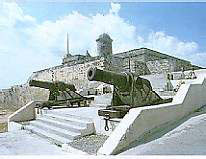 One of the tourist attractions in the city of Cienfuegos, its reconstruction was finished in 1745 and it was opened with the name of Castle of our Lady of the Angels of Jagua (Castillo de Nuestra Señora de los Ángeles de Jagua).
It has a circular tower with narrow vertical crenels. Its majestic cupola features a loophole that resembles an alert eye over the calm marine waters. This attractive castle has been restored so that the visitor can appreciate the original chapel as well as its damp cells and its deep moat, impossible to cross if the ramp is raised, all the while listening to the delicious legends of the place. The ancient old building, next to the Jagua Hotel that rises up at the far end of the Prado, boasts its condition as a National Monument.
One of the tourist attractions in the city of Cienfuegos, its reconstruction was finished in 1745 and it was opened with the name of Castle of our Lady of the Angels of Jagua (Castillo de Nuestra Señora de los Ángeles de Jagua).
It has a circular tower with narrow vertical crenels. Its majestic cupola features a loophole that resembles an alert eye over the calm marine waters. This attractive castle has been restored so that the visitor can appreciate the original chapel as well as its damp cells and its deep moat, impossible to cross if the ramp is raised, all the while listening to the delicious legends of the place. The ancient old building, next to the Jagua Hotel that rises up at the far end of the Prado, boasts its condition as a National Monument.
For more information:
www.cuba-history.com
,
www.cuba-cienfuegos.com
|
|
|
Martí Park, Cienfuegos
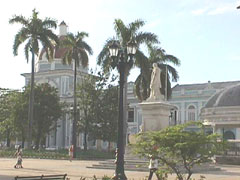 In the year of 1906 it was named for the National Hero after a central ensemble of sculptures was built in it, from an idea by the Italian artist Giovanni Nocolini. Fourteen years later the pedestal was built for the statue that symbolises the Republic. Since 1865 the area was enhanced by the presence of two lions sculpted in marble. The Arch of the Workers (Arco de los Obreros) is also from this time period; the workers of the Masons’ Guild raised it. With pride the people of Cienfuegos also exhibit the summerhouse and the busts that decorate the surroundings of this well cared for park, that has become an attraction due to its location and also because it is a National Monument.
In the year of 1906 it was named for the National Hero after a central ensemble of sculptures was built in it, from an idea by the Italian artist Giovanni Nocolini. Fourteen years later the pedestal was built for the statue that symbolises the Republic. Since 1865 the area was enhanced by the presence of two lions sculpted in marble. The Arch of the Workers (Arco de los Obreros) is also from this time period; the workers of the Masons’ Guild raised it. With pride the people of Cienfuegos also exhibit the summerhouse and the busts that decorate the surroundings of this well cared for park, that has become an attraction due to its location and also because it is a National Monument.
For more information:
www.cuba-cienfuegos.com
|
|
|
MARTÍN INFIERNO CAVERN
This important natural site is a cavern of enormous dimensions, whose initial formation dates back to the Pliocene Pleistocene. It is found in the upper part of Río Hondo, which drains its waters towards the southern coast. This is part of the northern slope of the Guamuaya mountain massif, in the municipality of Cumanayagua.
The cavern features the tallest stalagmite in Cuba and one of the largest in the world, according to the Speleologic Society of Cuba who carried out the measurement, its official height is 67,2 m.
It has a very large inclined cavity, with five great halls of vast proportions, that together with the rest of the galleries, sum up a linear total of 793 m and an off-level of 190 m.
Inside one can find the only “gypsum flowers” ("flores de yeso") reported in Cuban territory. They measure over 30 cm, and resemble a helicoidal or rolled up shape giving the impression of a flower. Also reported is the presence of another mineral rarity, that is formed by microcrystalline calcite known as "moon milk".
This is a site of infinite scientific discovery for learning about the evolution of the territory, due to the characteristics of the deposits that are found inside, as well as the evidence of endangered fauna such as the tocororo, the sijú owl and the Cuban kites and mountain hawks.
For more information:
www.cuba-ecotourism.com
,
www.cuba-geography.com
,
www.cuba-cienfuegos.com
|
|
|
REMAINS OF THE TRAIL (TROCHA) FROM JÚCARO TO MORÓN
A brief history of the Trail (Trocha) from Júcaro to Morón.
In the wars of 1868 and 1895, the Trocha was an insurmountable barrier, as the Spanish thought, and after it was finished, it became the most perfect and sophisticated military construction that the Spanish Colonialism had in America. Of course it was never a deterrent for the glorious Mambi Army (Ejército Mambí), who in both wars kept crossing it ,showing the ingenious strategies deployed by their military chiefs, among them Máximo Gómez and Antonio Maceo, with the help of other insurrectional chiefs of the area, such as Brigadier José Gómez Cardoso and Colonel Simón Reyes Hernández, known as the Eagle of the Trocha (El Águila de la Trocha).
The aim of this military line was to isolate the mambi forces in the eastern area, in order to deter help and break contact between the insurrectional forces in the central and eastern regions, and to stop the invaders, led by Máximo Gómez and Antonio Maceo from extending the war to the western region of the country, an event that would wear down the strength of Spanish colonialism, leading up to its final fall.
By the end of March of 1871, three years from the Cry of Yara (Grito de Yara), General Blas Villate de la Hera, Count of Valmaseda, proposed to the Overseas Minister of the Spanish Crown; the construction of a trocha or fortified line, from the port of Júcaro, on the southern coast; running across the island, to the settlement of Morón, on the northern coast.
Valmaseda’s proposal was approved, and construction on the trocha was started. It started out with 17 fortresses and in 1874, 16 bunkers had been added on, more than five thousand men were employed to guard it, these soldiers had modern infantry weapons as well as ten pieces of artillery, which were moved along the Trocha by a narrow railway, which also allowed them to quickly move the troops from one end to the other.
For more information:
www.cuba-heroes.com
,
www.cuba-history.com
,
www.cuba-matanzas.com
,
www.cuba-cienfuegos.com
,
www.cuba-villaclara.com
,
www.cuba-sanctispiritus.com
|
|
|
SANTA ISABEL DE LAS LAJAS
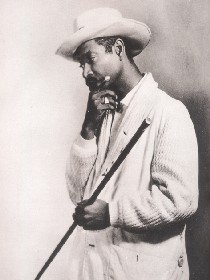 This is where Bartolomé “Benny” Moré was born, a man who became the most popular singer of boleros, sones and guarachas in the history of Cuban music.
Without studying music, he was able to write quite a number of songs and compositions, that came to life by way of the orchestra that he directed during the last years of his turbulent life.
Benny, among his vast repertoire, dedicated a song to his homeland and another to the neighbouring city of Cienfuegos.
This is where Bartolomé “Benny” Moré was born, a man who became the most popular singer of boleros, sones and guarachas in the history of Cuban music.
Without studying music, he was able to write quite a number of songs and compositions, that came to life by way of the orchestra that he directed during the last years of his turbulent life.
Benny, among his vast repertoire, dedicated a song to his homeland and another to the neighbouring city of Cienfuegos.
For more information:
www.cuba-perladelsur.com
,
www.cuba-cienfuegos.com
|
|
|
URBAN RESIDENTIAL AREA OF PUNTA GORDA, CIENFUEGOS

For more information:
www.cuba-culturaltours.com
,
www.cuba-geography.com
,
www.cuba-perladelsur.com
,
www.cuba-cienfuegos.com
|
|
|
Yaguaramas: the place where Henry Reeve, the Englishman (“El Inglesito”) fell in combat
It is a monument located along the road of Yaguaramas to Horquita, Abreus
At the place called "El Cayo del Inglés", between Yaguaramas and Horquita, in the municipality of Abreus, a modest monument was erected in memory of the place where Henry Reeve "El Inglesito", brigadier of the Liberating Army (Ejército Libertador) fell in combat, in August of 1876.
The Obelisk, in the shape of a column of solid concrete in square sections, has an irregular wall at the back and stone paved walkway. The whole place is surrounded by lush green lawns.
Considered by the Spanish as one of the most talented, brave and honourable Mambi chiefs, he was born in Brooklyn, United States and travelled to Cuba on board the steamboat "Perrit", commandeered by the American General Thomas Jordan. They were discovered, attacked and dispersed by the Spanish forces when they were docking near Banes, in the western part (Oriente) of the Island.
Reeve managed to escape and soon joined the legendary cavalry of Camaguey, led by the Major General Ignacio Agramonte “Bayardo”, of whom he became field assistant, taking part in many combats, among them the rescue of Brigadier Julio Sanguily.
For more information:
www.cuba-geography.com
,
www.cuba-heroes.com
,
www.cuba-history.com
,
www.cuba-cienfuegos.com
|
|
 This historical site, located in the municipality of Cruces, is within a park surrounded by a paved area that acts as an access to the obelisk. It has a stepped structure in a pyramidal form, and is located at the centre of the park surrounded by colonial ruins.
On December 15th of 1895, the invading column of Maceo and Gómez started moving in order to penetrate the territory of Cienfuegos; and made camp in Cruces, an important sugar region of the country’s central area.
In the settlement next to Mal Tiempo, the Spanish columns that were trying to cut off the advance of the Mambi troops, were attacked by the Cuban forces, producing a great battle in the middle of the Cienfuegos lands. This military and political feat covered the Invading Army (Ejército Invasor) with glory and dealt a hard blow to Spain’s aspirations of quenching the insurrectional struggle along the length of the island.
It was declared a National Monument on December 15th of 1981.
This historical site, located in the municipality of Cruces, is within a park surrounded by a paved area that acts as an access to the obelisk. It has a stepped structure in a pyramidal form, and is located at the centre of the park surrounded by colonial ruins.
On December 15th of 1895, the invading column of Maceo and Gómez started moving in order to penetrate the territory of Cienfuegos; and made camp in Cruces, an important sugar region of the country’s central area.
In the settlement next to Mal Tiempo, the Spanish columns that were trying to cut off the advance of the Mambi troops, were attacked by the Cuban forces, producing a great battle in the middle of the Cienfuegos lands. This military and political feat covered the Invading Army (Ejército Invasor) with glory and dealt a hard blow to Spain’s aspirations of quenching the insurrectional struggle along the length of the island.
It was declared a National Monument on December 15th of 1981. This hundred-year-old institution is the oldest of its kind in the country and offers the national as well as the foreign visitor the possibility of admiring well cared for plants originating from all parts of the planet. The incomparable greenery envelops the whole garden of the Pearl of the South and its palm collection is so complete that experts have stated that it can be considered one of the most complete worldwide.
Over a thousand species, from the exuberant Ceiba tree to a herbarium containing great varieties of the beautiful Caribbean flora, can be seen. This majestic park in Cienfuegos treasures many arboreal species as well as fruit trees, and includes an area for the conservation of exotic plants. Due to its attributes this botanical garden has been declared a National Monument.
This hundred-year-old institution is the oldest of its kind in the country and offers the national as well as the foreign visitor the possibility of admiring well cared for plants originating from all parts of the planet. The incomparable greenery envelops the whole garden of the Pearl of the South and its palm collection is so complete that experts have stated that it can be considered one of the most complete worldwide.
Over a thousand species, from the exuberant Ceiba tree to a herbarium containing great varieties of the beautiful Caribbean flora, can be seen. This majestic park in Cienfuegos treasures many arboreal species as well as fruit trees, and includes an area for the conservation of exotic plants. Due to its attributes this botanical garden has been declared a National Monument.
 Located some 244 kilometres from the capital, in the south central region of the country, this city features the beautiful Bay of Jagua (Bahía de Jagua), in whose deep waters abound shads, a species coveted by fishermen.
Traditionally, there are rowing competitions held here and the beaches such as Rancho Luna and El Inglés are wonderful scenarios for scuba diving and contemplating the beautiful marine corals, among them Notre Dame with its impressive six feet of height.
The well named Pearl of the South (Perla del Sur), founded by the French, received the condition of City in 1880
Located some 244 kilometres from the capital, in the south central region of the country, this city features the beautiful Bay of Jagua (Bahía de Jagua), in whose deep waters abound shads, a species coveted by fishermen.
Traditionally, there are rowing competitions held here and the beaches such as Rancho Luna and El Inglés are wonderful scenarios for scuba diving and contemplating the beautiful marine corals, among them Notre Dame with its impressive six feet of height.
The well named Pearl of the South (Perla del Sur), founded by the French, received the condition of City in 1880 Due to its great historical value, it is among the sites considered as National Monuments. It is also known as Queen Cemetery (Cementerio de Reina). Twenty years after its founding, it was the first that the southern villa had, that today has become a beautiful city, where one can find combined architecture of the XIX, XX and XXI centuries.
According to specialists, the gravestones of the niches are true treasures of statuary art in bas-relief as well as most of the marble sculptures, among them those of the Sleeping Beauty (La Bella Durmiente), which has become a popular legend. The grounds of the cemetery are outstanding due to the exquisite iron grates, magnificent works of art, that unveil the fine skills of the craftsmen that made them over 150 years ago.
Due to its great historical value, it is among the sites considered as National Monuments. It is also known as Queen Cemetery (Cementerio de Reina). Twenty years after its founding, it was the first that the southern villa had, that today has become a beautiful city, where one can find combined architecture of the XIX, XX and XXI centuries.
According to specialists, the gravestones of the niches are true treasures of statuary art in bas-relief as well as most of the marble sculptures, among them those of the Sleeping Beauty (La Bella Durmiente), which has become a popular legend. The grounds of the cemetery are outstanding due to the exquisite iron grates, magnificent works of art, that unveil the fine skills of the craftsmen that made them over 150 years ago.
 One of the tourist attractions in the city of Cienfuegos, its reconstruction was finished in 1745 and it was opened with the name of Castle of our Lady of the Angels of Jagua (Castillo de Nuestra Señora de los Ángeles de Jagua).
It has a circular tower with narrow vertical crenels. Its majestic cupola features a loophole that resembles an alert eye over the calm marine waters. This attractive castle has been restored so that the visitor can appreciate the original chapel as well as its damp cells and its deep moat, impossible to cross if the ramp is raised, all the while listening to the delicious legends of the place. The ancient old building, next to the Jagua Hotel that rises up at the far end of the Prado, boasts its condition as a National Monument.
One of the tourist attractions in the city of Cienfuegos, its reconstruction was finished in 1745 and it was opened with the name of Castle of our Lady of the Angels of Jagua (Castillo de Nuestra Señora de los Ángeles de Jagua).
It has a circular tower with narrow vertical crenels. Its majestic cupola features a loophole that resembles an alert eye over the calm marine waters. This attractive castle has been restored so that the visitor can appreciate the original chapel as well as its damp cells and its deep moat, impossible to cross if the ramp is raised, all the while listening to the delicious legends of the place. The ancient old building, next to the Jagua Hotel that rises up at the far end of the Prado, boasts its condition as a National Monument.
 In the year of 1906 it was named for the National Hero after a central ensemble of sculptures was built in it, from an idea by the Italian artist Giovanni Nocolini. Fourteen years later the pedestal was built for the statue that symbolises the Republic. Since 1865 the area was enhanced by the presence of two lions sculpted in marble. The Arch of the Workers (Arco de los Obreros) is also from this time period; the workers of the Masons’ Guild raised it. With pride the people of Cienfuegos also exhibit the summerhouse and the busts that decorate the surroundings of this well cared for park, that has become an attraction due to its location and also because it is a National Monument.
In the year of 1906 it was named for the National Hero after a central ensemble of sculptures was built in it, from an idea by the Italian artist Giovanni Nocolini. Fourteen years later the pedestal was built for the statue that symbolises the Republic. Since 1865 the area was enhanced by the presence of two lions sculpted in marble. The Arch of the Workers (Arco de los Obreros) is also from this time period; the workers of the Masons’ Guild raised it. With pride the people of Cienfuegos also exhibit the summerhouse and the busts that decorate the surroundings of this well cared for park, that has become an attraction due to its location and also because it is a National Monument. This is where Bartolomé “Benny” Moré was born, a man who became the most popular singer of boleros, sones and guarachas in the history of Cuban music.
Without studying music, he was able to write quite a number of songs and compositions, that came to life by way of the orchestra that he directed during the last years of his turbulent life.
Benny, among his vast repertoire, dedicated a song to his homeland and another to the neighbouring city of Cienfuegos.
This is where Bartolomé “Benny” Moré was born, a man who became the most popular singer of boleros, sones and guarachas in the history of Cuban music.
Without studying music, he was able to write quite a number of songs and compositions, that came to life by way of the orchestra that he directed during the last years of his turbulent life.
Benny, among his vast repertoire, dedicated a song to his homeland and another to the neighbouring city of Cienfuegos.
